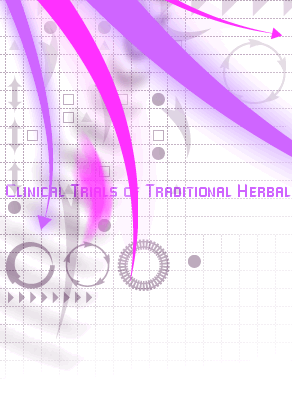| |
|
|
 |
|
A Phase 1 study to validate the regulation and methodology in the analysis of traditional herbal medicine in Clinical Research
|
 |
|
|
 |
Today more than ever, traditional herbal medicine is receiving scientist’s attentions in order to stimulate evidence-based research and proper archiving. Although practitioners claim that use of traditional herbal medicines can make a real difference in various therapies, there are still doubts about the monitoring of herbal practitioners, and the safety and accuracy of their therapies. Certain studies have recorded adverse reactions leading to serious damages (Journal of Chinese Medicine 1996) [1]. The World health organisation, with the help of 19 member countries, is setting up an International Regulatory Cooperation for herbal Medicines (IRCH) [2] (as from November 2005). Its aim is to protect and promote public health and safety through improved regulation for herbal medicines. The British Government, member of this committee, along with national and international health bodies is reviewing its legislation concerning the use of traditional herbal medicines. The conventional legislation of the Medicines for Human Use (Clinical Trials) Regulations 2004 [3] had some limitations regarding its enforcement on traditional herbal medicines. The Medicines (Traditional Herbal Medicinal Products for Human Use) Regulations 2005 [4] was therefore introduced to give to The Medicines and Healthcare products Regulatory Agency (MHRA 2007) more legislative power and responsibility concerning the management of herbal medicines on the U.K market. The statutory document is based on the Traditional Herbal Medicinal Products Directive 2004/24 EC [5] by the European Union Directive. It ensures specific safety and quality standards of traditional herbal medicines on the British market. However, there is still a transitional period for old products on the market to comply with the new legislation by 2011 (MHRA 2007) [6]. This project is specially designed to assess the use of these traditional herbal medicines. With the transitional period of the new legislation, the project is based on the rules of the 2004 conventional legislation. The legislation will regulate the use of a highly consumed traditional herbal medicine, Cinnamomum, in a phase 1 Clinical Trials study. Aim: The aim of this project is to carry out a herbal medicines clinical trials under the Human Use (Clinical Trials) Regulations 2004 set up by The Medicines and Healthcare products Regulatory Agency (MHRA). Objectives: The objective of this project will mainly be focused on: 1. Application of the Medicines for Human Use (Clinical Trials) Regulations 2004 to the analysis of Traditional Herbal Medicines. 2. Ensure the use of the most appropriate documents, without causing any harm to the patient’s rights, safety and welfare according to Good Clinical Practice.
Hence, Cinnamomum will be tested as a main product in a phase 1 Clinical Trials. This will help to compare the limitations of the conventional legislation compared to the new legislation at the end of the project. A full report will be documented at the end of the study.
|
 |
|
|
 |
Rayish Ramrakha
Health Professional Council Registered Biomedical Scientist
Member of the Institute of Biomedical Science
BSc (Hons) Biomedical ScienceStudent in MSc Blood Science
Project title: A Phase 1 study to validate the regulation and methodology in the analysis of traditional herbal medicine in Clinical Research
Product to be tested: Cinnamomum (Cinnamon)
Product Description: Cinnamomum is an ancient herbal medicine used by Chinese practitioners 2800B.C. The dried inner bark of the shoots and the oil distilled from the bark and leaves are used as traditional medicinal products. Recent studies have determined that consuming a very small amount of Cinnamomum each day may reduce blood sugar, cholesterol and triglyceride levels by as much as 20% in Type-2 diabetes patients who are not taking insulin (Roberta Lee, MD, and Michael J. Balick, PhD 2005) [7].
Phase of Clinical Trials: Phase 1
Population: 30 – 50 volunteers. Healthy Volunteers aged 18 to 50. Only healthy volunteers, not suffering from diabetes or illnesses directly or indirectly affected by Cinnamomun administration, will be recruited
Contacts:
Through Dr Sundus Tewfik
Room T12-02, Tower Building,
London Metropolitan University
166-220 Holloway Road
London
N7 8DB
rayish@ramrakha.co.uk
|
 |
|
|
 |
Dr Sundus Tewfik
BSc, MSc, PhD
University Position/Role: Senior Lecturer Pharmaceutical Science, Course Leader BSc Herbal Medicinal Science, Course Leader BSc Cosmetic Science, Placements Tutor, Research Interest Group (RIG) Co-ordinator.
Subject Specialism: Pharmacognosy, Natural products characterisation, Phytochemicals
Contacts:
Through Dr Sundus Tewfik
Room T12-02, Tower Building,
London Metropolitan University
166-220 Holloway Road
London
N7 8DB
s.tewfik@londonmet.ac.uk
020 7133 4359
|
 |
|
|
 |
1. Blackwell Richard, Adverse events involving certain Chinese herbal medicines and the response of the profession (1996) Journal of Chinese Medicine Number 50 January 1996
2. International Regulatory Cooperation for Herbal Medicines (IRCH), World Health organisation, November 2005, http://www.who.int/en/, accessed on 19th Nov 2009
3. The Medicines for Human Use (Clinical Trials) Regulations 2004, Statutory Instrument 2004 No. 1031, Crown Copyright 2004, http://www.opsi.gov.uk/si/si2004/20041031.htm, accessed on 19th Nov 2009
4. The Medicines (Traditional Herbal Medicinal Products for Human Use) Regulations 2005, Statutory Instrument 2005 No. 2750, Crown Copyright 2005, http://www.opsi.gov.uk/si/si2005/20052750.htm, accessed on 19th Nov 2009
5. Official Journal of the European Union (2004), directive 2004/24/EC of the European parliament and of the council, Strasbourg, 31 March 2004
6. MHRA (2007) Traditional Herbal Medicines Registration Scheme, The Medicines and Healthcare products Regulatory Agency, March 2007
7. Roberta Lee, MD, and Michael J. Balick, PhD (2005) sweet wood – cinnamon and its importance as a spice and medicine, Explore, Vol. 1, No.1, pg 61 – 64, January 2005
|
 |
|
|
|
|











